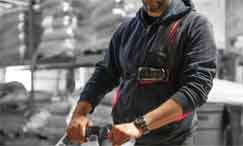A Brooklyn, NY-based company called StrongArm Technologies says it expects 35,000 warehouse workers will be wearing its safety monitoring devices by the end of next year.
The StrongArm device is about the size of a smartphone and is worn on a sort of harness in the front of the body. The system then tracks a worker's every move, looking for behaviors that could lead to injuries, such as bending too deeply to pick up a box or twisting too much to set one down, according to an article last week on Bloomberg.com.
When a worker crosses an ergonomic line, the device on the worker's chest vibrates to send a warning that his or her chance of getting hurt is increased.
Supply Chain Digest Says... |
|
|
StrongArm says it has some 30 customers and that users of its system include Walmart, 3PL Geodis, Heineken and Toyota. Walmart says it's testing StrongArm in eight distribution centers. StrongArm says about 15,000 workers have worn its devices to date, and most of them use it daily.
Strong Arm is also establishing relationships with insurance companies interested in ways to reduce workers compensation costs. It cites a recent study it commissioned that found users wearing them suffered 20% to 50% fewer injuries than without its device.
Privacy advocates are critical of the system, but StrongArm says it's not tracking individual productivity and that its products aren't used to punish individual workers or to contest worker compensation claims.
Of course, companies have been tracking the productivity of DC workers for decades, often using “engineered labor standards” and supported by what is termed Labor Management System (LMS) software for decades – measuring work done by DC associates at highly granular levels of detail.
Engineered standards are often used to more accurately measure workers' achievement against goals say in order picking by considering the difficulty of a given task versus another – such as how high up on a forklift a picker has to go to select the cartons needed for an order, or factoring in that heavy boxes take longer to pick that lighter one.
Long established, LMS solutions to date have not tracked the type of ergonomic data captured by the StrongArm and other systems. But perhaps that could change.
Mike Honious, the chief operating officer for the Americas at Geodis, told Bloomberg that one day it might combine the productivity and safety data into a single system so it can improve both safety and efficiency. He waves off worries about surveillance: "I actually believe they're emotional concerns," he told Bloomberg.
But emotional or not, the concerns can be very real. A pilot of the StrongArm system at a GE factory in Massachusetts actually failed last year, in part it appears due to worker resistance – even though the union at first supported the technology as a way to reduce injuries.
(See More Below)
|
CATEGORY SPONSOR: SOFTEON |
|
|
| |
|
|
 Bloomberg says the when Toyota began planning a pilot with StrongArm, its plan was to use the data to compare individual workers so as to identify those who were exhibiting behavior associated with higher injury risk. But the Toyota retreated from that plan by the time its pilot began last month in Princeton, Indiana, though it says it is still interested in doing those comparisons in the future. Bloomberg says the when Toyota began planning a pilot with StrongArm, its plan was to use the data to compare individual workers so as to identify those who were exhibiting behavior associated with higher injury risk. But the Toyota retreated from that plan by the time its pilot began last month in Princeton, Indiana, though it says it is still interested in doing those comparisons in the future.
When StrongArm devices started to be deployed at Geodis this year, rumors quickly spread through the workforce that the devices had cameras and microphones, though management was eventually able to quell such resistance.
StrongArm founder and CEO Sean Petterson says that most employers lack an understanding of what in going on ergonomically at DCs and factories. Managers walking the floor can at best address issues they actually see, and workers quickly stop bad practices if they see management coming by. Hence, the need for an automated monitoring system.
Geodis' Honious agrees, telling Bloomberg that the potential of StrongArm is to use the data to redesign DC processes, given its ability to monitor productivity at such a granular level. "We can actually break it down by the second. Then you apply the ergonomics data to the exact same timeline, and you can see the motions of the person bending, and what they're doing," he said.
What do you think of the StrongArm systems? Should workers be worried or not? Let us know your thoughts at the Feedback section below.
|